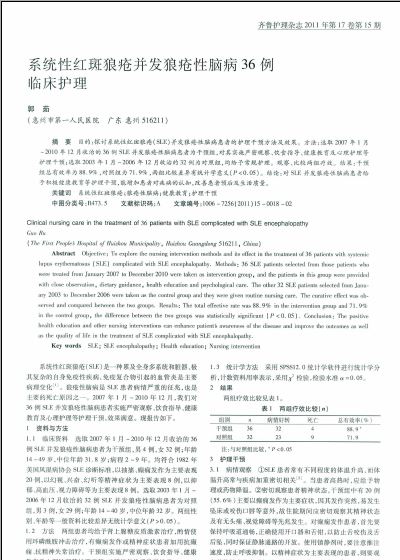系统性红斑狼疮并发狼疮性脑病36例临床护理(1)
 |
| 第1页 |
参见附件。
摘 要 目的:探讨系统性红斑狼疮(SLE)并发狼疮性脑病患者的护理干预方法及效果。方法:选取2007年1月~2010年12月收治的36例SLE并发狼疮性脑病患者为干预组,对其实施严密观察、饮食指导、健康教育及心理护理等护理干预;选取2003年1月~2006年12月收治的32例为对照组,均给予常规护理。观察、比较两组疗效。结果:干预组总有效率为88.9%,对照组为71.9%,两组比较差异有统计学意义(P<0.05)。结论:对SLE并发狼疮性脑病患者给予积极健康教育等护理干预,能增加患者对疾病的认知,改善患者预后及生活质量。
关键词 系统性红斑狼疮;狼疮性脑病;健康教育;护理干预
中图分类号:R473.5 文献标识码:A 文章编号:1006-7256(2011)15-0018-02
Clinical nursing care in the treatment of 36 patients with SLE complicated with SLE encephalopathy
Guo Ru
(The First People's Hospital of Huizhou Municipality, Huizhou Guangdong 516211, China)
Abstract Objective: To explore the nursing intervention methods and its effect in the treatment of 36 patients with systemic lupus erythematosus (SLE) complicated with SLE encephalopathy. Methods: 36 SLE patients selected from those patients who were treated from January 2007 to December 2010 were taken as intervention group, and the patients in this group were provided with close observation, dietary guidance, health education and psychological care. The other 32 SLE patients selected from January 2003 to December 2006 were taken as the control group and they were given routine nursing care. The curative effect was observed and compared between the two groups. Results: The total effective rate was 88.9% in the intervention group and 71.9% in the control group, the difference between the two groups was statistically significant (P<0.05). Conclusion: The positive health education and other nursing interventions can enhance patient's awareness of the disease and improve the outcomes as well as the quality of life in the treatment of SLE complicated with SLE encephalopathy.
Key words SLE; SLE encephalopathy; Health education; Nursing intervention
系统性红斑狼疮(SLE)是一种累及全身多系统和脏器、极其复杂的自身免疫性疾病,免疫复合物引起的血管炎是主要病理变化[1]。狼疮性脑病是SLE患者病情严重的征兆,也是主要的死亡原因之一。2007年1月~2010年12月,我们对36例SLE并发狼疮性脑病患者实施严密观察、饮食指导、健康教育及心理护理等护理干预,效果满意。现报告如下。
1 资料与方法
1.1 临床资料 选取2007年1月~2010年12月收治的36例SLE并发狼疮性脑病患者为干预组,男4例,女32例;年龄14~49岁,中位年龄31.8岁;病程2~9年。均符合1982年美国风湿病协会SLE诊断标准,以抽搐、癫痫发作为主要表现20例,以幻视、兴奋、幻听等精神症状为主要表现8例,以抑郁、高血压、视力障碍等为主要表现8例。选取2003年1月~2006年12月收治的32例SLE并发狼疮性脑病患者为对照组,男3例,女29例;年龄14~40岁,中位年龄32岁。两组性别、年龄等一般资料比较差异无统计学意义(P>0.05)。
1.2 方法 两组患者均给予肾上腺糖皮质激素治疗,酌情使用环磷酰胺冲击治疗,有癫痫发作或精神症状患者加用抗癫痫、抗精神失常治疗。干预组实施严密观察、饮食指导、健康教育及心理护理等护理干预;对照组仅给予常规护理。
1.3 统计学方法 采用SPSS12.0统计学软件进行统计学分析,计数资料用率表示,采用χ2检验,检验水准α=0.05。
2 结果
两组疗效比较见表1。
3 护理干预
3.1 病情观察 ①SLE患者常有不同程度的体温升高,而体温升高常与疾病加重密切相关[2]。当患者高热时,应给予物理或药物降温。②密切观察患者精神状态,干预组中有20例(55.6%)主要以癫痫发作为主要症状,因其发作突然,易发生坠床或咬伤口唇等意外 ......
您现在查看是摘要介绍页,详见PDF附件(1523kb)。